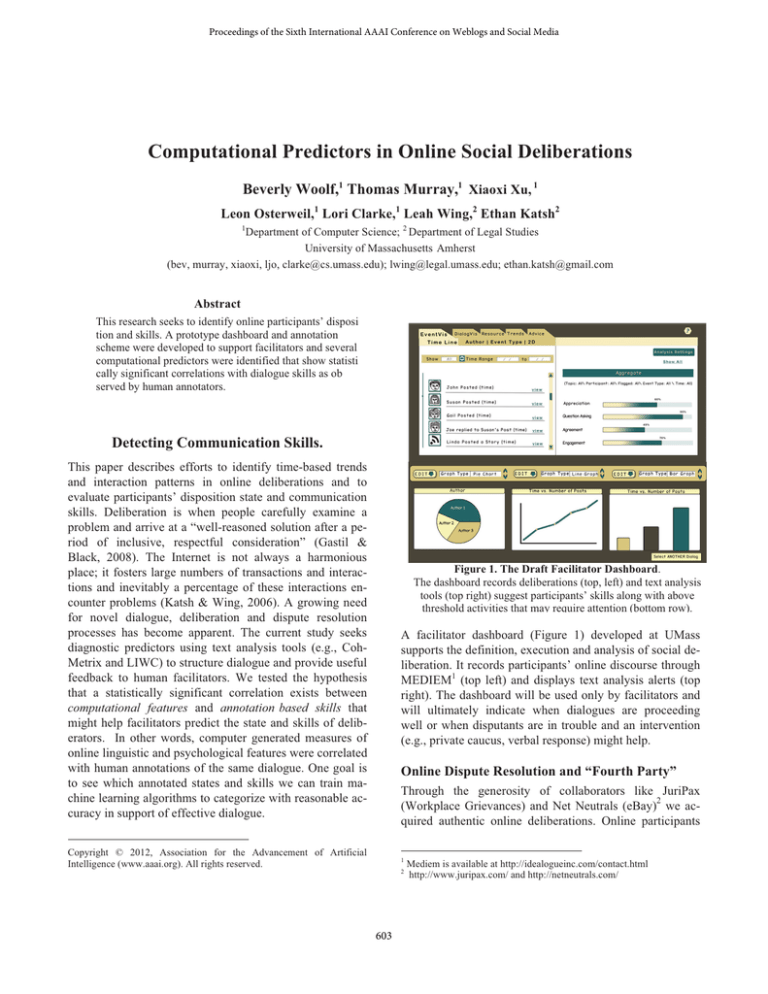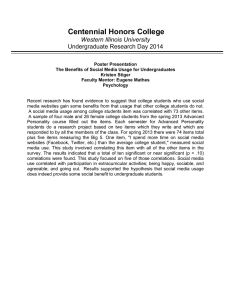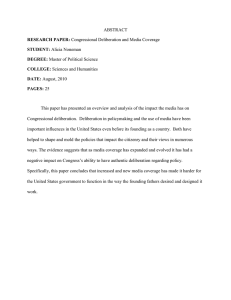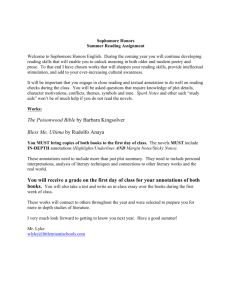
Proceedings of the Sixth International AAAI Conference on Weblogs and Social Media
Computational Predictors in Online Social Deliberations
Beverly Woolf,1 Thomas Murray,1 Xiaoxi Xu, 1
Leon Osterweil,1 Lori Clarke,1 Leah Wing,2 Ethan Katsh2
1
Department of Computer Science; 2 Department of Legal Studies
University of Massachusetts Amherst
(bev, murray, xiaoxi, ljo, clarke@cs.umass.edu); lwing@legal.umass.edu; ethan.katsh@gmail.com
Abstract
This research seeks to identify online participants’ disposi
tion and skills. A prototype dashboard and annotation
scheme were developed to support facilitators and several
computational predictors were identified that show statisti
cally significant correlations with dialogue skills as ob
served by human annotators.
Detecting Communication Skills.
This paper describes efforts to identify time-based trends
and interaction patterns in online deliberations and to
evaluate participants’ disposition state and communication
skills. Deliberation is when people carefully examine a
problem and arrive at a “well-reasoned solution after a period of inclusive, respectful consideration” (Gastil &
Black, 2008). The Internet is not always a harmonious
place; it fosters large numbers of transactions and interactions and inevitably a percentage of these interactions encounter problems (Katsh & Wing, 2006). A growing need
for novel dialogue, deliberation and dispute resolution
processes has become apparent. The current study seeks
diagnostic predictors using text analysis tools (e.g., CohMetrix and LIWC) to structure dialogue and provide useful
feedback to human facilitators. We tested the hypothesis
that a statistically significant correlation exists between
computational features and annotation based skills that
might help facilitators predict the state and skills of deliberators. In other words, computer generated measures of
online linguistic and psychological features were correlated
with human annotations of the same dialogue. One goal is
to see which annotated states and skills we can train machine learning algorithms to categorize with reasonable accuracy in support of effective dialogue.
Figure 1. The Draft Facilitator Dashboard.
The dashboard records deliberations (top, left) and text analysis
tools (top right) suggest participants’ skills along with above
threshold activities that may require attention (bottom row).
A facilitator dashboard (Figure 1) developed at UMass
supports the definition, execution and analysis of social deliberation. It records participants’ online discourse through
MEDIEM1 (top left) and displays text analysis alerts (top
right). The dashboard will be used only by facilitators and
will ultimately indicate when dialogues are proceeding
well or when disputants are in trouble and an intervention
(e.g., private caucus, verbal response) might help.
Online Dispute Resolution and “Fourth Party”
Through the generosity of collaborators like JuriPax
2
(Workplace Grievances) and Net Neutrals (eBay) we acquired authentic online deliberations. Online participants
Copyright © 2012, Association for the Advancement of Artificial
Intelligence (www.aaai.org). All rights reserved.
1
2
603
Mediem is available at http://idealogueinc.com/contact.html
http://www.juripax.com/ and http://netneutrals.com/
often discuss different options, make decisions, collaborate
and in general go through processes that are analogous to
face-to-face deliberative discussion (Black et al., 2011).
Mediation, in which parties resolve their problem under the
guidance of an acceptable third party, is an alternative way
to solve conflicts. Online Dispute Resolution explores
ways in which computer and communication technologies
can facilitate dispute resolution while also decreasing the
3
degree of human involvement (Katsch, 1996). The “third
Annotation
Question topic
Reflect back
Back Reference
Solution
Negative emotion
Mediate
Meta statement
During the Analysis Phase each discourse was further analyzed using software packages, Linguistic Inquiry and
Word Count (LIWC) and Coh-Metrix, to identify linguistic
and rhetorical relations. LIWC (Pennebaker and Francis,
1999) reports the percentage of words in a given text devoted to grammatical (e.g., articles, pronouns), or content
categories (e.g., home, occupation, religion). Coh-Metrix
provides an array of measures based on levels of words,
syntax, situation model, rhetorical structure, genre and
pragmatic communication (Graesser et al., 2004; McNamara et al., 2006).
Deliberation Behavior
Ask questions to discover more.
Explicit reflection of
words or ideas
Reference what another said, including quoting, summarizing.
A proposed solution, or suggest
what participants should do
Negative emotion about interlocutors, or dialog process or topic;
disrespect, insult; anger.
Suggestions about how interlocutors should communicate.
Highlight or summarize, e.g.,
consensus, disagreement.
Workplace Grievance: 524 segments, 60 posts, 2 parties, 1 mediator
The director of a company can no longer work with an employee. She
says he must be terminated and she can’t come to a solution with him.
The employee says his boss wants to get rid of him and the place makes
him sick. A human mediator supports both parties.
Example Dispute:
“There are numerous examples where the employee loudly disagreed
with proposed measures.” (Provide evidence.)
“Ryker does not need to leave, but agreements need to be made about
how to proceed further.” (State issues)
Table 1. Social Deliberative Coding Scheme
A sample of the 46 annotations for online deliberation,
some correlate with computational predictors (bold).
Faculty Deliberation: 507 segments, 71 posts, 15 parties, no mediator
Faculty from one academic community scheduled a conference that interferes with another conference. The dialogue involves both communities to
decide whether to reschedule the conference. By the end of the discussion
four people have resigned.
party” delivers instructions, questions, and other types of
messages that resembled the manner in which a face-toface third party would interact with disputants. Technology
is seen as a “fourth party” that focuses attention on capabilities that machines have and that humans might not, e.g.,
to model and monitor dialogue and provide data (Katsh &
Rifkin, 2002; Katsh b& Gaitenby, 2003).
Example Dispute:
“I’m pleased to see this initiative.” (Acknowledge)
“I have no desire to be ruled.” “We do not want to be a part of that type
of community.” (Negative emotion)
“I am very disappointed in your decision;” “I will elect to spend my energies elsewhere and resign.” (Negative emotion)
Table 1. Authentic online disputes and human annotations.
When participants are in agreement, more informal language may be used with features associated with every day
oral conversation as in the beginning of the Faculty Dialogue when participants were appreciative and hopeful. By
the end of the dialogue, many people had resigned and the
rate of emotion, self-reflection and meta-summary had increased. At the beginning of the conversation, Coh-Metrix
detected high narrativity correlated with participants questioning the topic and providing acknowledgement. However, when the conversation became difficult, as in the case
of participants not agreeing, the language shifted to being
more stilted with a serious slant and persuasion pitch.
We analyzed the Workplace Grievance and Faculty Deliberations described in Table 2. These dialogues were no
longer being argued, meaning that they did not change during the time of our analysis, making the annotation process
manageable.
During the Annotation Phase we used a newly developed
Social Deliberative Coding Scheme, see Table 1 (Murray
et al., 2012) to assess how well the parties achieved problem-solving tasks (analytic dimensions) and then analyzed
aspects of relational communication (social dimensions)
(Black et al., 2011). We collected 202 annotated segments
from the Faculty and 217 from the Workplace discourse
and performed an inter-rater reliability test for two human
annotations, using Cohen’s Kappa statistics. The fair interrater agreement (around 25%) highlights the difficulty of
annotating deliberative skills from online disputation.
During the Correlation Phase, we evaluated the hypothesis that features from LIWC and Coh-metrix will predict
online participants’ skills as identified by human annotators, Figure 2. The computational discourse features included 25 features selected from 80 LIWC indices and 8
features from over 100 Coh-Metrix indices. We carried out
a correlation analysis between text analysis features and
)
http://odr.info/nodr/32%(("""&&((./*&
3
604
Figure 2. Workplace Dispute. Statistically significant correlations between text analysis (left) and human annotations (right) are indicated.
Agreed correlation values are listed on the top/bottom of each double line and single correlations by dashed lines.
2, double lines indicate agreed correlations, in that both
inter-rater agreement between annotators agreed about the
annotations and dashed lines indicate significant correlations, but only for a single annotator. Text analysis features for the Workplace Deliberation (Figures 2, left) can
be seen as diagnostic predictors for the corresponding human annotated skills (right). In both Workplace and Faculty dialogues we found agreed correlations between discourse features and the human annotations of negative
emotion about topic, reflect others, mediate and question
topic.
each set of human annotations, in part because of the low
inter-rater agreement between annotators. Using annotations from a single annotator to identify correlations can
sometimes find significant correlations by chance. However, if significant correlations were present between discourse features and both sets of annotations, we would
have more confidence to claim that those significant correlations are not due to sampling errors and judgment biases.
We call these correlations agreed correlations.
Results
In the Workplace Deliberation, Figure 2, we found significant agreed correlations between text analysis results and
the human annotations of reflection of another (right),
which were negatively correlated with question marks.
Question marks are rarely used to quote and summarize
messages from others. The human annotations of mediate
were negatively correlated with negative emotion and
We calculated statistically significant correlations between
features detected by the text analysis tools and human annotations at the confidence level of 95%. We used a P
value of 0.05 for the one-tailed significant test, meaning
that we are 95% confident about rejecting the null hypothesis (i.e., no significant correlations exists). In Figure
605
question marks. Professional mediators are trained to be
neutral and impersonal and would use few negative emotions. The human annotations of question topic were positively correlated with four predictors, question marks, nar
rativity, referential cohesion, and temporal cohesion. The
characteristics of narrativity are often present in oral language where sentence constructions are easy for the audience to comprehend, such as shorter noun phrases, fewer
words before the main verbs of main clauses, and fewer
passive constructions. Referential cohesion characterizes to
what extent content words and ideas are connected with
each other. Questions about topics inevitably reference
back ideas mentioned previously and thus can have a positive correlation with referential cohesion and temporal cohesion. And finally the human annotations of metasummation were positively correlated to 1st person plural;
clearly the word “we” is used when participants summarize
a consensus or conflict.
liver alerts when deliberations are not proceeding well and
when interventions might be useful. We have tested the effectiveness of a mock-up dashboard in a Wizard-of-Oz experiment with college students (Murray et al., 2012).
Acknowledgments
This research was funded by an award from the NSF
#0968536, The Fourth Party: Improving ComputerMediated Deliberation through Cognitive, Social and Emotional Support, Beverly Woolf (PI), Lori Clarke, Leon
Osterweil, Thomas Murray and Ethan Katsh. Any
opinions, findings, conclusions or recommendations are
those of the authors and do not necessarily reflect the
views of the funding agencies.
References
Agreed correlations in the Faculty Deliberations (not
shown) found significant correlation between negative
emotion about topic, which were positively correlated to
negative emotion and tentative, and quotation marks.
Negative emotion, uncertain statements, and referencing
back are likely to be used by participants when they present negative accounts of a topic. The human annotations
of reflection of another were positively correlated to con
junction, which is frequently used to quote and summarize
what others say. The human annotation of mediate was
positively correlated with 1st person plural and cognitive
process. Mediators inevitably use the word “we” and employ cognitive processes to learn the conflicts of disputant
parties and make suggestions about how a conversation
should proceed.
Black, L., Welser, H., Cosley, D., and DeGroot, J., (2011) Self
Governance Through Group Discussion in Wikipedia Measuring
Deliberation in Online Groups, Small Group Research 2011 42
D’Mello, S., Dowell, N., and Graesser, A., Cohesion Relation
ships in Tutorial Dialogue as Predictors of Affective States.
Gastil, J., & Black, L. W. (2008). Public deliberation as the or
ganizing principle in political communication research. Journal of
Public Deliberation, 4.
Graesser, A.C., McNamara, D.S., Louwerse, M., & Cai, Z.
(2004). Coh Metrix: Analysis of text on cohesion and language.
Behavior Research Methods, Instruments, & Computers, 36, 193
202.
Katsh E. and Wing L. (2006) Ten Years of Online Dispute Reso
lution: Looking At The Past and Constructing The Future, 38 U.
Tol. Law Rev. 19 (2006 2007)
Katsh, E. and Rifkin (2002) J., Online Dispute Resolution: Re
solving Disputes in Cyberspace. San Francisco: Jossey
Katsh, E., and Gaitenby A. (2003) Introduction: Technology as
the "Fourth Party" Proceedings of the UNECE Forum on ODR
2003 http://www.odr.info/unece2003.
Katsh, E., (1996) Dispute Resolution in Cyberspace, 28 CONN.
L. REV. 953 (1996); E. Casey Lide.
McNamara, D., Ozuru, Y., Graesser, A, Louwerse M., (2006)
Validating Coh Metrix. In R. Sun & N. Miyake (Eds), Proceed
ings of the 28th Annual Conference of the Cognitive Science
Scociety (pp. 573). Mahwah, NJ: Eribaum.
McNamara, D.S. (2001). Reading both high coherence and low
coherence texts: Effects of text sequence and prior knowledge.
Canadian Journal of Experimental Psychology, 55, 51 62.
#$&$$&&$ $&$
&$"
&$&
) * " ! #$'
#$ -+,-&
Pennebaker JW, Francis ME. (1999) Linguistic Inquiry and Word
Count
(LIWC).
Mahwah,
NJ:
Erlbaum.
The agreed correlations described above are domain dependent, with only one predictor (question marks) positively correlated with question topics in both domains. We
will use datasets from more domains to see if this phenomenon still persists.
Discussion and Future Work
We found significant correlation between computational
deliberation predictors and human annotations for the same
dialogue. Our intention is to integrate such text analysis
tools into a real-time dashboard that might enable facilitators to manage several deliberations and gain a high level
view of the nature of the discussion. One goal is to provide
a high level view of the nature of deliberation and to de
606




